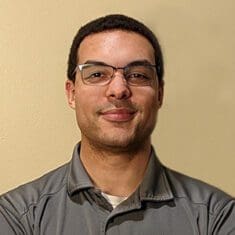Tyamo Okosun, Ph.D.
Associate Director for Research | Associate Professor of Mechanical Engineering (by courtesy)
Research Associate Professor - Purdue University Northwest, Steel Manufacturing Simulation and Visualization Consortium

Introduction
Tyamo Okosun is a Research Associate Professor with the Center for Innovation through Visualization and Simulation (CIVS). He received a Ph.D. in mechanical engineering from Purdue University in 2018 after receiving a B.S. in mechanical engineering from PNW in 2009. His research focus is on the simulation of multiphase reacting flows, with specific work in the fields of gas and solid combustion in iron and steelmaking, aerodynamics and wind power, and computational fluid dynamics model development. He currently leads research in ironmaking and electric arc furnace modeling, among related steelmaking research at the Steel Manufacturing Simulation and Visualization Consortium (SMSVC). His applied research is aimed at developing methods and technologies for improving energy efficiency, reducing waste, minimizing carbon emissions, and improving process stability.
Research Overview
W. Shang, J. Chen, T. Okosun, C. Q. Zhou, J. Entwistle, B. Rodgers, J. Morey, K. Leontaras, “Real-time Non-invasive Velocity Field Measurement of Molten Iron Jet Discharged from Blast Furnace,” JOM (2023), https://doi.org/10.1007/s11837-023-05860-0
T. Okosun, S. Nielson, C. Q. Zhou, “Blast Furnace Hydrogen Injection: Investigating Impacts and Feasibility with Computational Fluid Dynamics,” JOM, Vol 74, Iss. 4 (2022), p.1521.
S. Nielson, T. Okosun, B. Damstedt, M. Jampani, C. Q. Zhou, “Tuyere-Level Syngas Injection in the Blast Furnace: A Computational Fluid Dynamics Investigation,” Processes, Vol 9, Iss. 8 (2021), p.1447.
T. Okosun, S. Nielson, J. D’Alessio, S. Ray, S. Street, C. Q. Zhou, On the Impacts of Pre-heated Natural Gas Injection in Blast Furnaces, Processes, Vol. 8, Iss. 7 (2020), p.771.
T. Okosun, A. K. Silaen, C. Q. Zhou, “Review on Computational Modeling and Visualization of the Ironmaking Blast Furnace at Purdue University Northwest,” Steel Research International, Vol. 90, Iss. 4 (2019).
Why I became an engineer…
Like many of us, I loved airplanes and supercars as a child. Aerodynamics was a fascinating topic, and one that I pursued in my education. Eventually, this led me to the field of Computational Fluid Dynamics, and I discovered the wide range of applications CFD has in many industries, including one very close to home for the Northwest Indiana region, iron and steel.
What engineers can do to make a difference…
There are a myriad of challenging issues facing our world today, but perhaps none so pressing as the need to manage, control, and eliminate carbon emissions from our industry and economy. This is a unique moment in time, one in which engineers can play a critical role in developing solutions to ensure a stable future for our modern world by doing what they do best: developing and implementing new ideas and solutions to make life easier, better, and more productive.